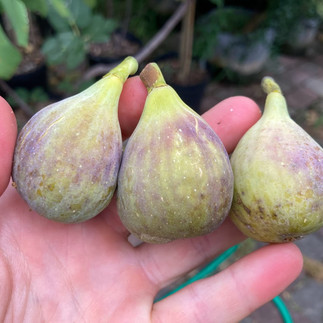De La Roca Fig | Comprehensive Variety Review
There are 1000s of fig varieties in existence, but fig varieties like De La Roca are worth learning about. Check out the other comprehensive variety reviews I’ve created on other fig varieties on the variety directory page found here:
Want to learn more about fig varieties? Subscribe to the Fig Boss newsletter at the top of the page for more fig-related information!
And check out my recent video on this variety to learn more about it below!
Varietal Characteristics
Origin: Spain
Categorization: Unifera
Similar varieties: None
Taste grouping: Complex Berry
Texture: Jammy
Size: Medium
Ripening period: Late
Vigor: High
Rain resistance: Above average
Shape: Pyriforme
Hang time: Below average
Split resistance: Above average
Climate preference: Well adapted
Hardiness: Unknown
Taste rating: 4.9/5
Light requirements: Unknown
Productivity: Unknown
History and Other Information
The name "De La Roca" translates to "Of the Rock" in English. I couldn’t think of a cooler name. Originating from Montserrat Pons' collection in Mallorca, Spain, this fig has possibly adapted to humid conditions given its history in a garden with frequent irrigation. While its late ripening initially made me hesitant to label it as one of the best, my growing experience has since moved me toward thinking of it as a top choice, especially for those with a prolonged growing season. This is not just because of its exceptional taste, which is indeed noteworthy, but also due to its overall performance.
In terms of physical characteristics, De La Roca has a pyriform shape, resembling the Coll de Damas figs in size, but without the typical fat neck. What really sets this fig apart is its remarkable drying quality. It outperforms even renowned varieties like Coll de Damas, resulting in consistently high-quality fruit. The taste when less ripe is reminiscent of LSU Tiger: chewy skin encompassing a fruity pulp. Though not excessively berry-like, its eating experience is always undeniably remarkable.
A photo of Coll de Dama Blanc

Now, comparing it to the well-known Coll de Dama varieties, De La Roca shines bright. The true magic lies in its ability to dry on the tree with ease. This means it offers superb resistance to rain and splitting, consistently producing high-quality figs that achieve peak ripeness. The texture and shape are quite similar to the CDDs, but it reigns supreme, especially in humid locations. When these figs intensify due to the climate, they transform into a semi-dried or dried fig, amplifying their flavor. It's like savoring a fig from California, but right here in Philadelphia. For me, it offers one of the best eating experiences.
Even in Pennsylvania's challenging climate, this variety demonstrates significant rain resistance and can dry on the tree, leading to a more consistent high fruit quality.. Its "hang time" is short, which means it ripens quickly—a crucial trait in rainy regions. Despite a shaky start a few years back, the tree has proven to be bountiful, producing beautiful fruit with a dense, jammy interior.
Photos of De La Roca










